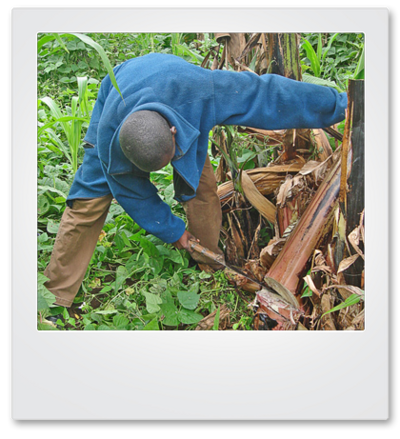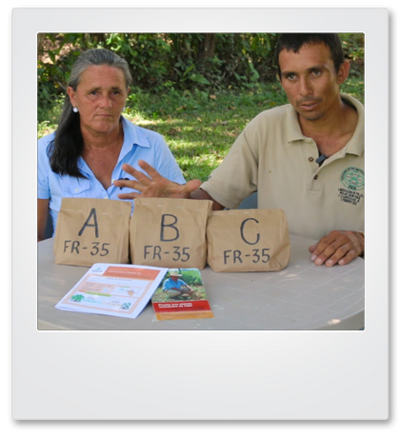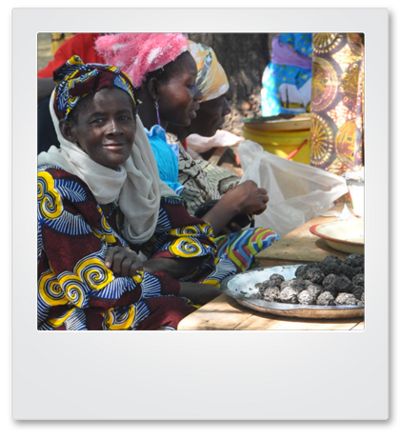Disrupting agricultural and tree biodiversity science – a review of Bioversity International’s 2017

On the International Day of Biological Diversity, which in 2018 marks 25 years of action for biodiversity, our Director General, Ann Tutwiler is proud to launch Bioversity International’s 2017 Annual Report, which celebrates our science, our partners and how agrobiodiversity nourishes people and sustains the planet.
Experts from the Committee on World Food Security tell us that we need disruptive change within and across today’s varied and complex food systems. Board Chair, Julia Marton-Lefèvre, and I agree! We believe that scientists at Bioversity International have been doing just that. For the past 40 years, they have been demonstrating how incorporating agrobiodiversity into our food and farming systems can drive disruptive changes.
In the 2017 Annual Report, published today on the International Day for Biological Diversity, we will take you on a virtual trip around the world where you will find scientific evidence, management practices and policy options to use and safeguard agricultural and tree biodiversity to attain sustainable global food and nutrition security.
The report presents highlights from 2017 as we continue moving towards reaching our strategic objectives: CONSUME diverse, affordable, nutritious diets, PRODUCE in resilient, productive and diversified farms and landscapes, PLANT a diversity of quality seeds and other planting materials, and SAFEGUARD priority agrobiodiversity for current and future needs.
Consume a diverse, affordable and nutritious diet
Bioversity International explores how agrobiodiversity can be better used within food production systems to improve access to nutritionally-rich food sources and increase dietary diversity.
In our 2017 report, we put vitamin A-rich bananas from South Asia and the Pacific to the taste test in Burundi and the Democratic Republic of Congo. For over seven years, Bioversity International and partners have studied whether new varieties of these regionally beloved crops can be accepted into local diets to help tackle vitamin A deficiency in places where it is one of the most serious health issues.
An exciting study co-authored by our nutrition specialists introduces a new food biodiversity indicator capable of evaluating the correlation between agricultural biodiversity and diet quality. “Food system sustainability, biodiversity and nutrition are current hot topics, yet we didn’t actually have any validated indicators that could measure the nexus between these three. Now we do,” writes our Australia-based Nutrition Research Specialist, Jessica Raneri.
Produce in resilient, productive and diversified farms and landscapes
The use of agrobiodiversity can increase long-term productivity by reducing risks from pests and diseases, helping systems adapt to climate change, and supporting pollination, water cycling and soil improvement. We explore how this diversity within the broader landscape can improve productivity, deliver ecosystem services, improve rural livelihoods and enhance resilience.
In our 2017 report, you will discover that crop variety mixtures can prove to be a real recipe for success. Our scientists report that farmers in Uganda who grow varietal mixtures of crops perceive a yield increase of up to 28%. These results are boosting farmers' motivations to use agricultural biodiversity for more resilient production systems.
In addition, the Single Diseased Stem Removal (SDSR) method is helping to restore banana productivity to smallholder farm families in the Democratic Republic of Congo (DRC). In South Kivu, DRC, devastating banana bacterial disease Xanthomonas wilt arrived in 2011 and by January 2013 it had infected 80% of the banana mats. In just three months after farmers started using SDSR, incidence of diseased banana stems dropped from above 80% to below 2%.
Plant a diversity of quality seeds and other planting materials
Farm households and rural communities need access to a diversity of quality seeds and planting materials to enhance productivity, nutrition and adapt to environmental change. Bioversity International works with diverse stakeholders to develop smart seed systems that will improve the productivity and resilience of food production systems, and the diversity and quality of diets.
We know that community seedbanks play a key role in conserving crop varieties, which contribute to food security, sustainable agriculture and agrobiodiversity. What we need to further stress, as described in our report, is that community seedbanks can also help farmers adapt to climate change, thus they need to be acknowledged and supported in national policies.
Another study takes a segmentation approach to on-farm crop diversity and the reasoning behind to why farmers choose (or don’t choose) to plant crop diversity. This study ‘segments’ farmers from Papua New Guinea into pragmatists, marketers, exhibitionists and novelty seekers to discover that when it comes to planting decisions, the ‘type’ of farmer matters as much as the type of crop.
A key ingredient to Bioversity International’s research is crowdsourcing and working with multiple stakeholders, especially farmers, to make sure that their wisdom and needs are validated and this can help to set priorities for selecting seed diversity. As described in two studies in Ethiopia and Honduras, farmers can play a much more concrete part in developing a diversity of seeds to plant. The 'tricot' technique – short for triadic comparison of technologies – gives many more farmers the ability to provide valuable information on different crop characteristics that are important to them. At the same time, linking what farmers want to the genes that underpin those qualities gives plant breeders targets to aim at when developing new varieties.
Safeguard priority agricultural biodiversity for current and future needs
Bioversity International targets rural communities, scientists, breeders and policymakers with information on priority traits of useful crop and tree species. We also promote global actions for monitoring and safeguarding priority agrobiodiversity to increase current and future options for improved productivity, nutrition and adaptation to environmental change.
Conserving plant genetic resources in farmers' fields so that they can evolve with changing conditions is often said to be a good thing, yet without very much evidence. A study highlighted in our 2017 Annual Report examines and makes the case for in situ conservation because – no matter how carefully maintained – genebank samples will inevitably lose some diversity in storage. Whereas in farmers’ hands crops will produce new variations and rare traits will be preserved.
In Burkina Faso, during the lean season, the number of severely food insecure people can increase six fold to over 600,000 people. In such cases, forest foods such as wild fruits, nuts and animal products provide a lifeline but many tree species are under threat, mainly due to climate change. Recommendations from a Bioversity International co-authored study include urgent collections of seeds for planting in more suitable climates and for conserving in ex situ collections.
When we talk about the use of plant diversity, we cannot ignore the policy behind it. Automated DNA sequencing and other technology breakthroughs require us to re-examine developing countries' – well, their farmers’ – ability to benefit from them and whether these benefits are falling between the cracks in international access and benefit sharing (ABS) agreements. A rethink of the current ABS is in order if the world is to stand any chance of using agrobiodiversity to meet the Sustainable Development Goals, warns our Head of Policy, Michael Halewood and colleagues.
Partners
Fundamental to such successes are the partnerships that Bioversity International has built, with CGIAR Centres and Research Programs including national and regional research institutes, civil society organizations, development agencies, government departments, academia and the private sector. The power of partnerships – in helping foster outcomes and contributing to important scientific outputs – is a key strategy that will continue to inform Bioversity International’s strategy going forward.
We hope you enjoy reading our 2017 Annual Report and finding out more about how agricultural and tree biodiversity is nourishing people and sustaining the planet. We thank all of our research, resource and implementation partners for their critical support and look forward to fruitful collaboration in future.




